April 2024
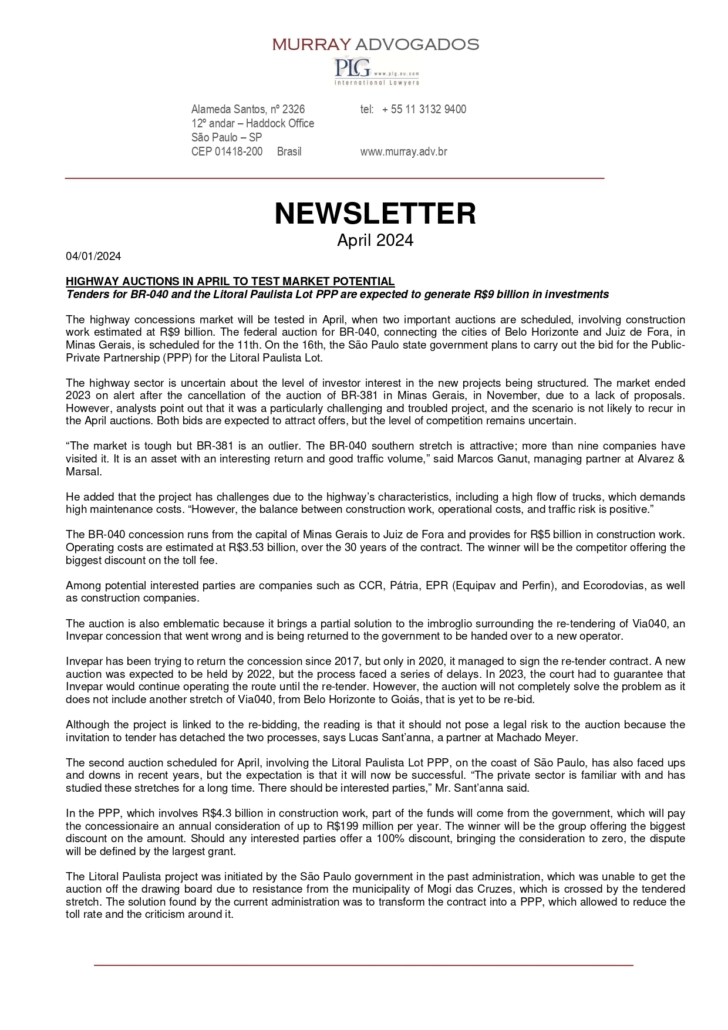


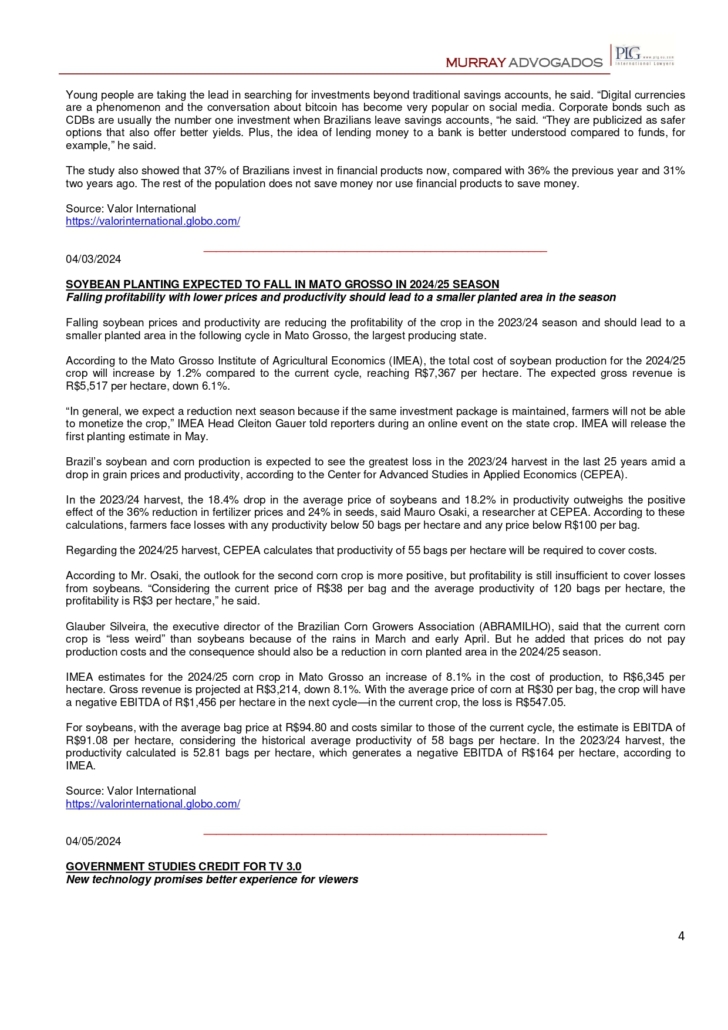
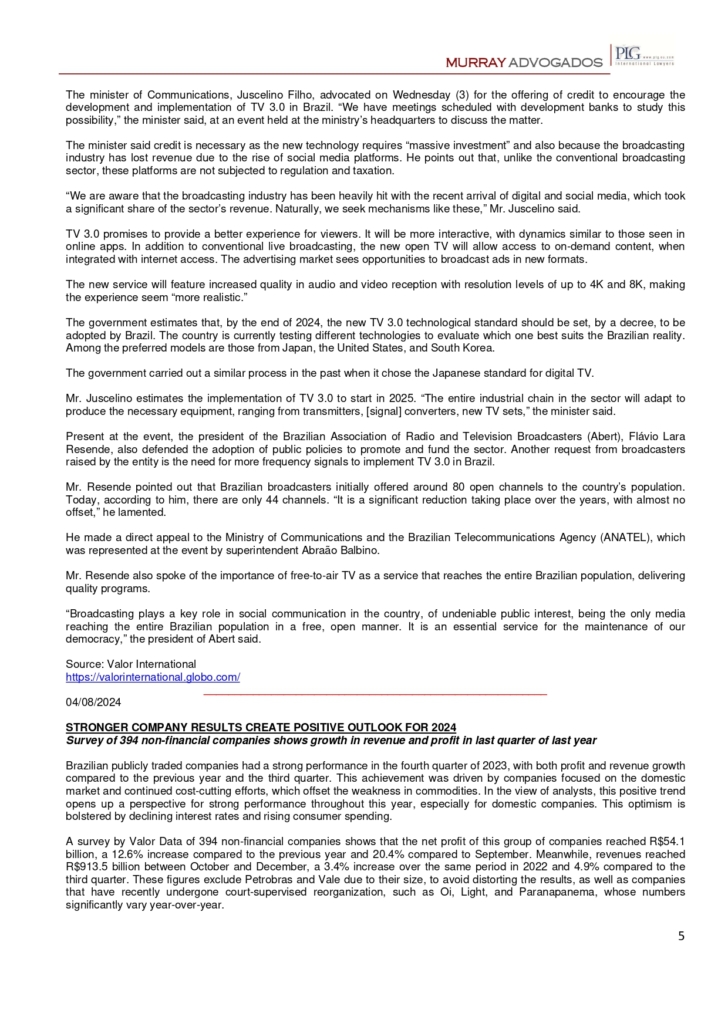
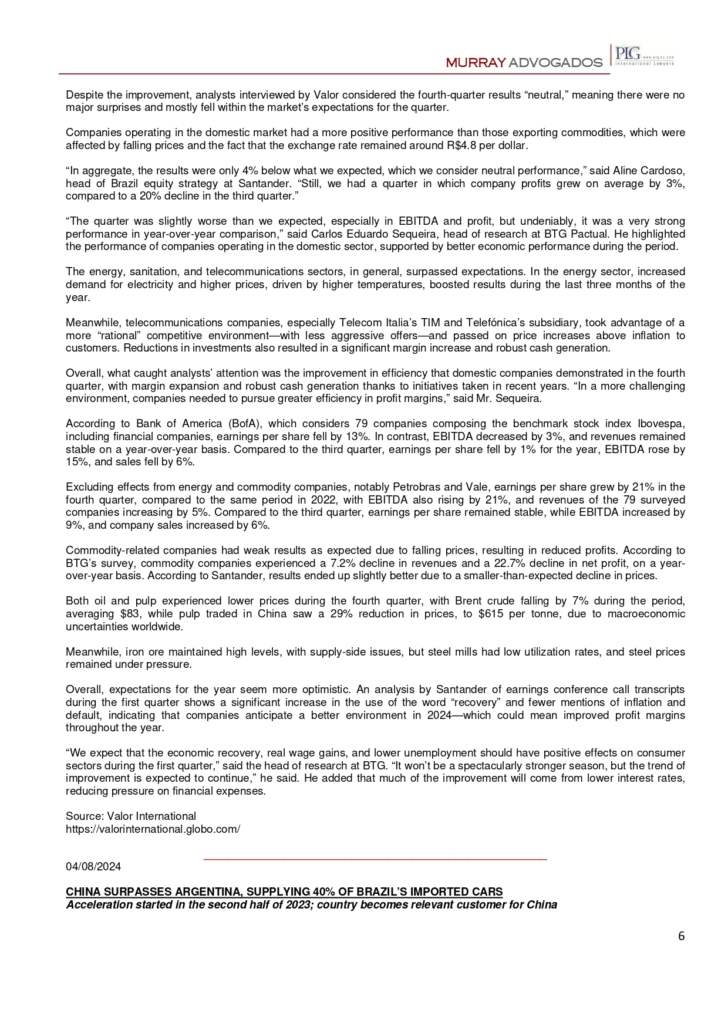
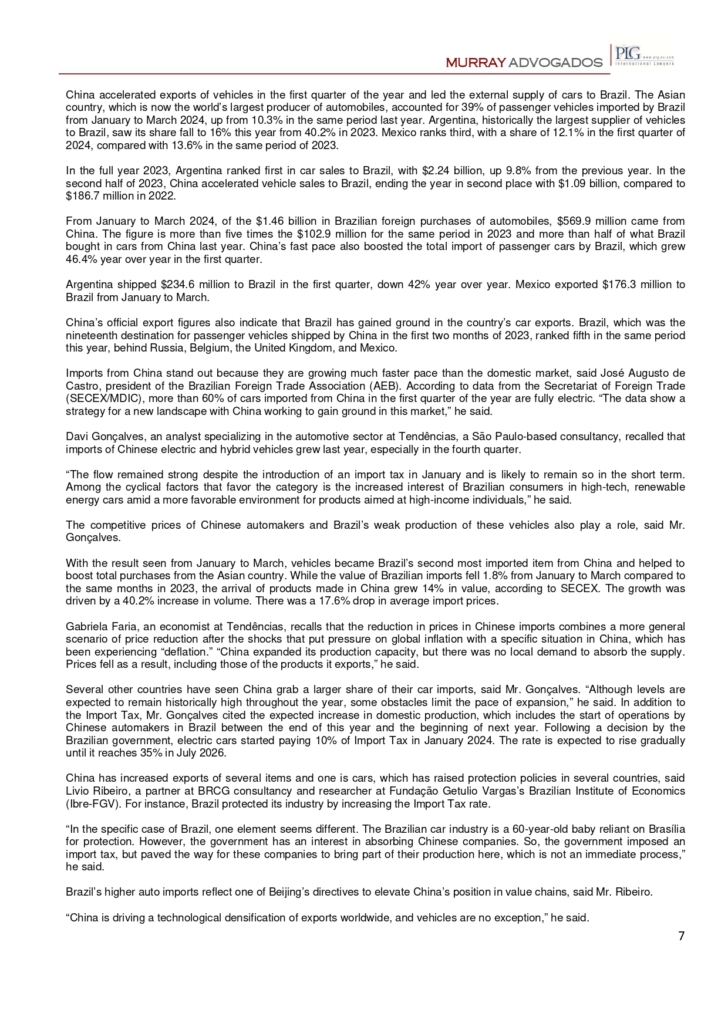
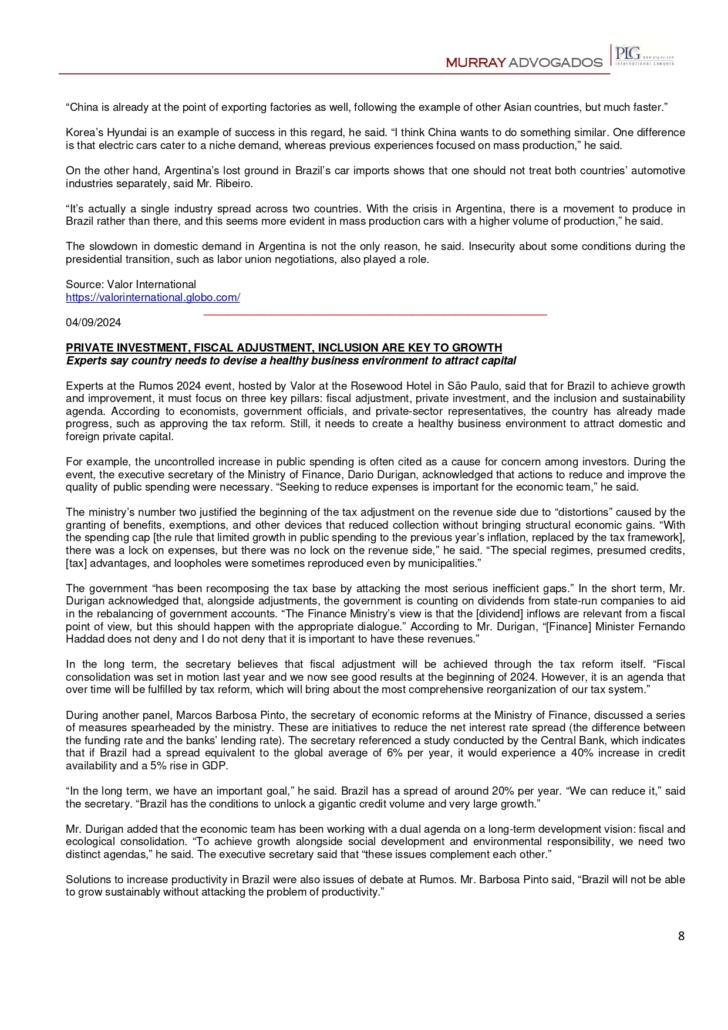
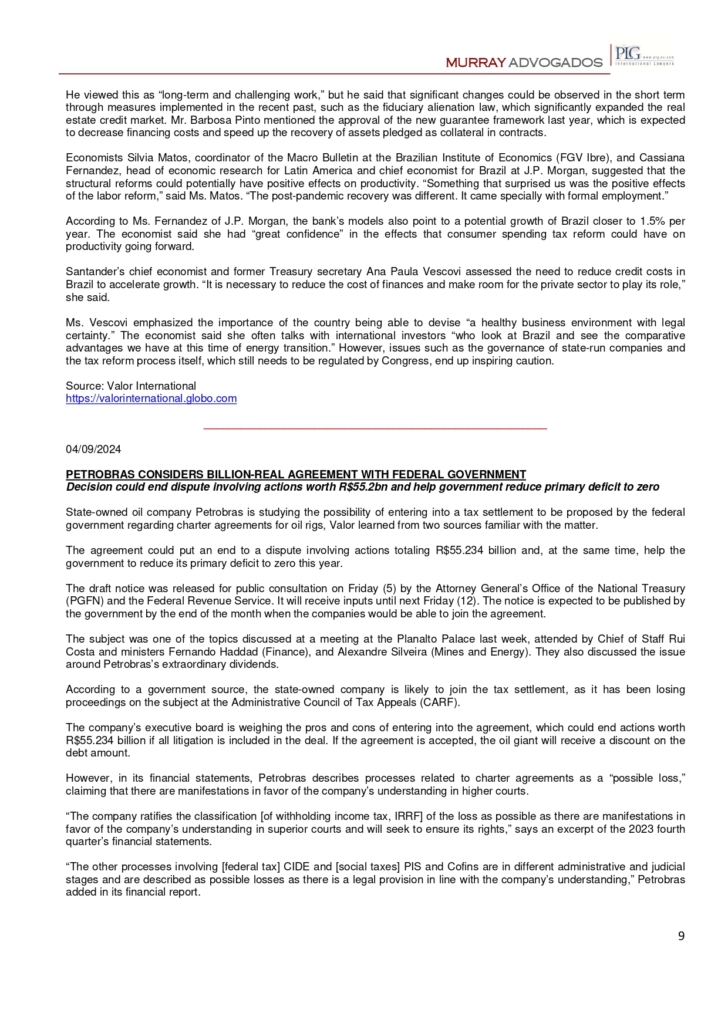



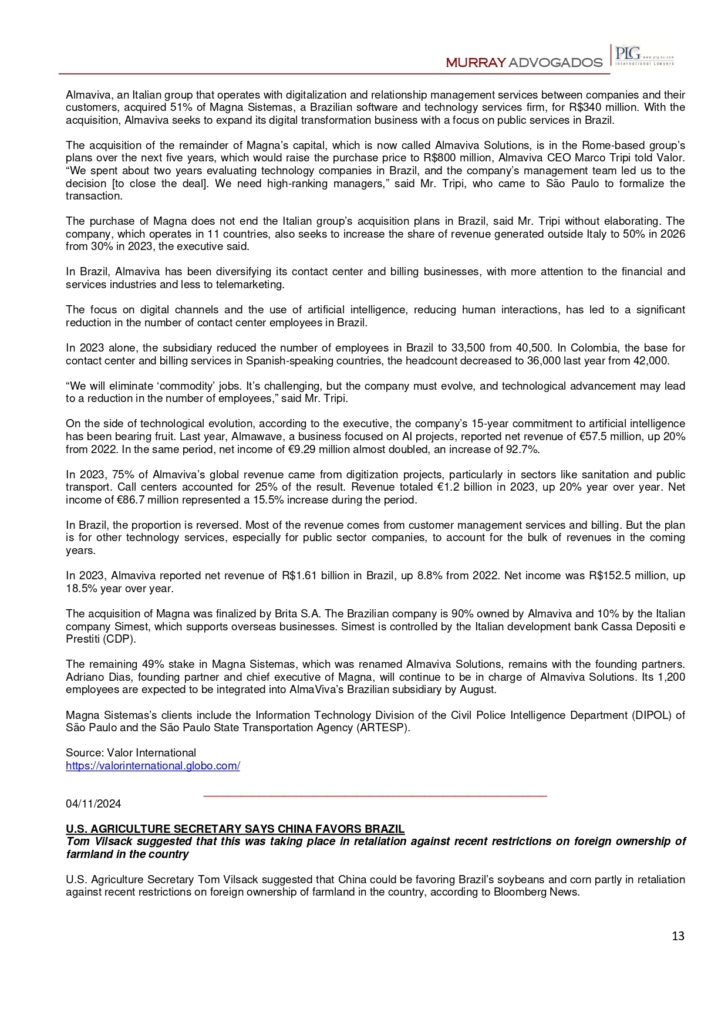
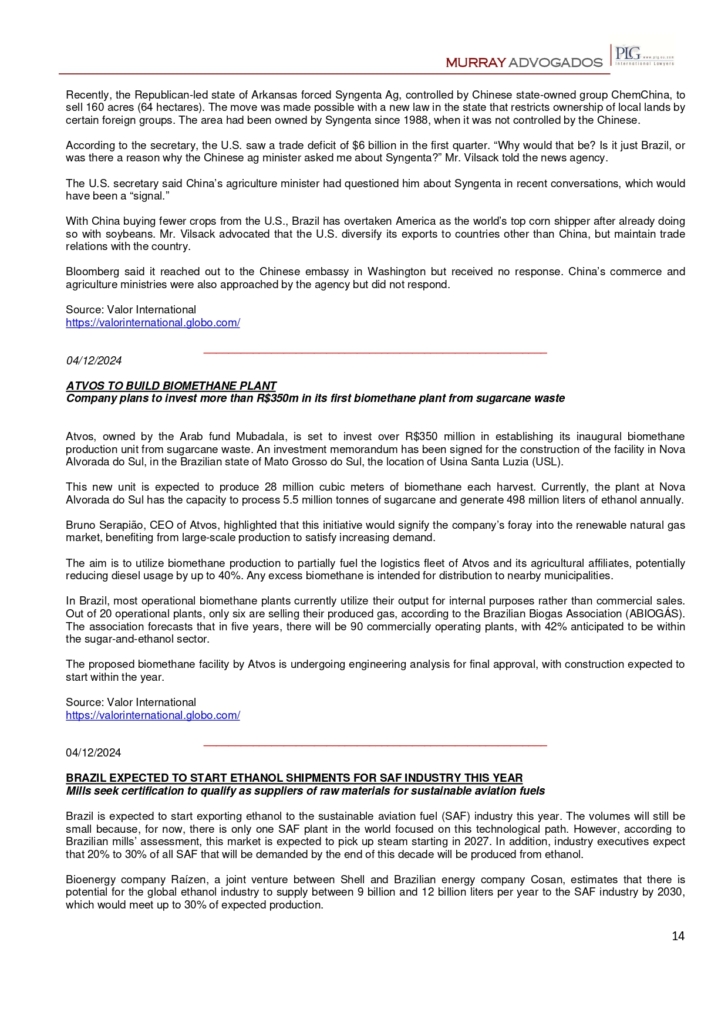

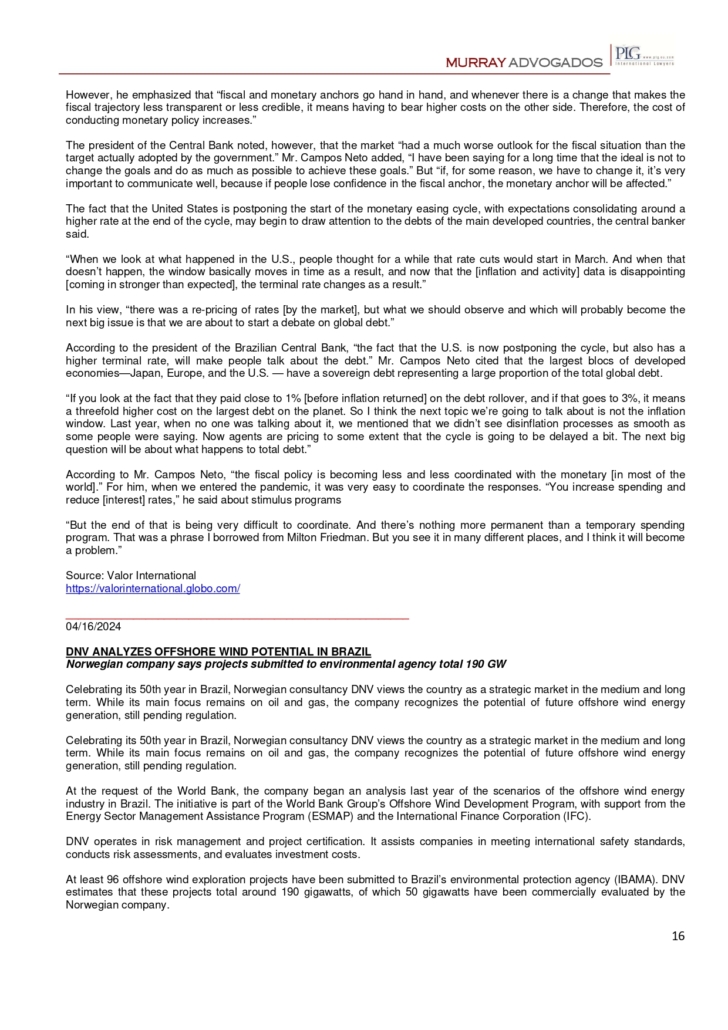
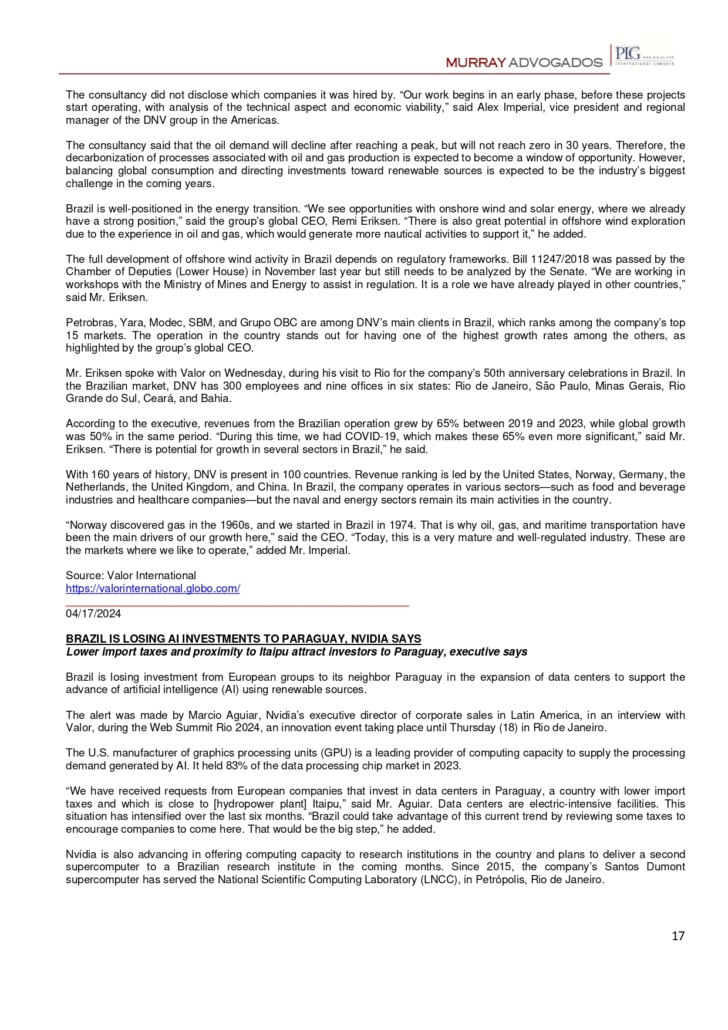

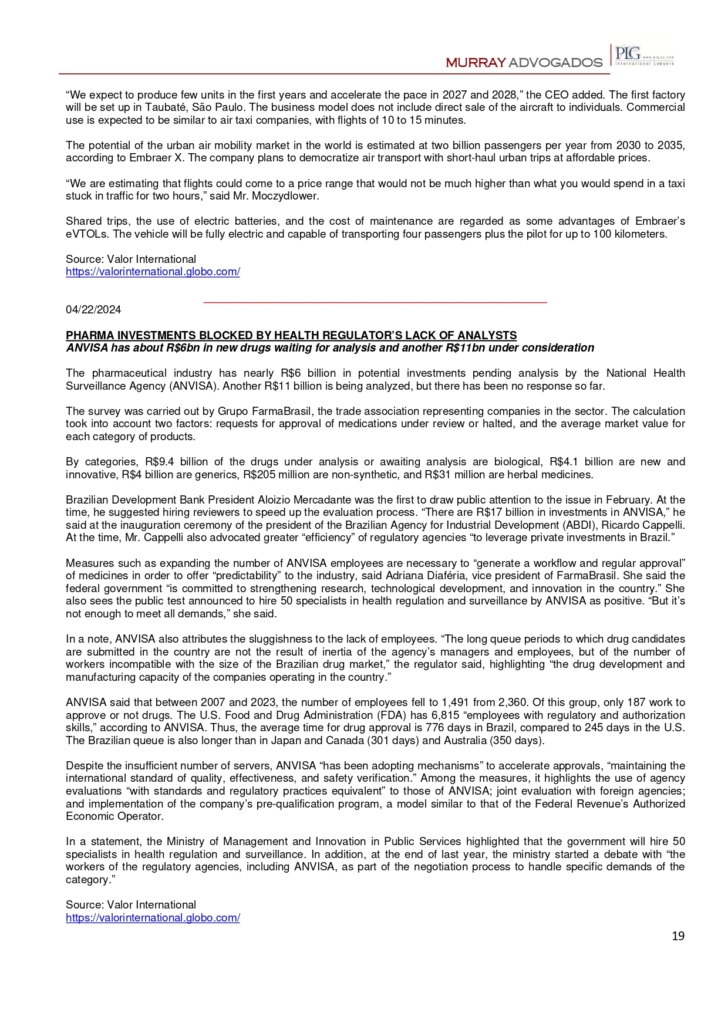

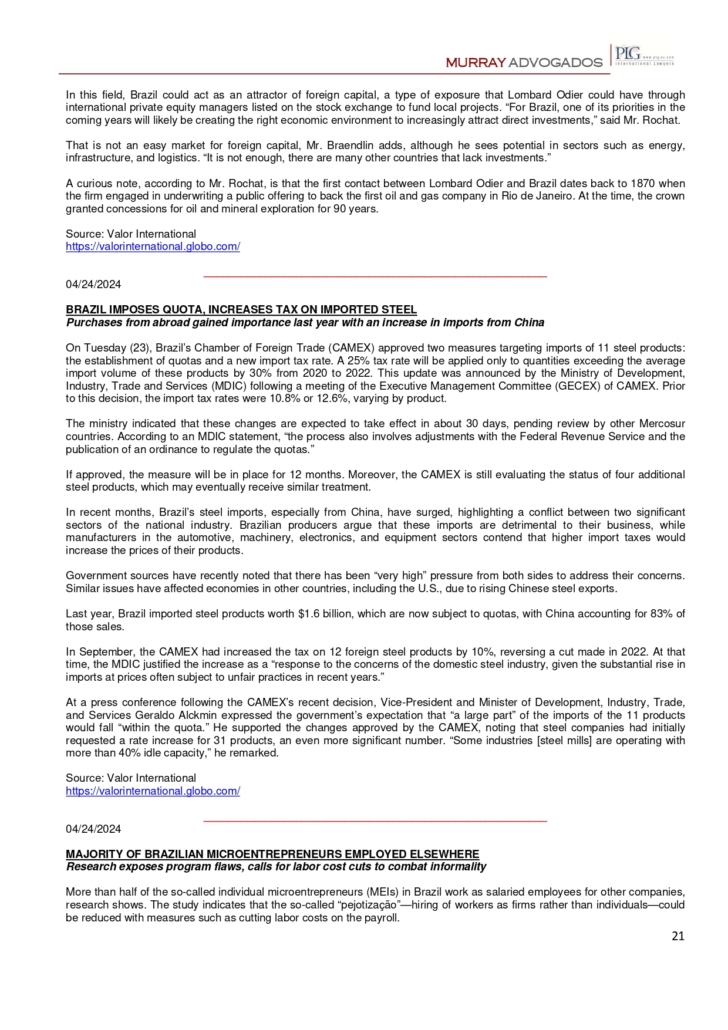

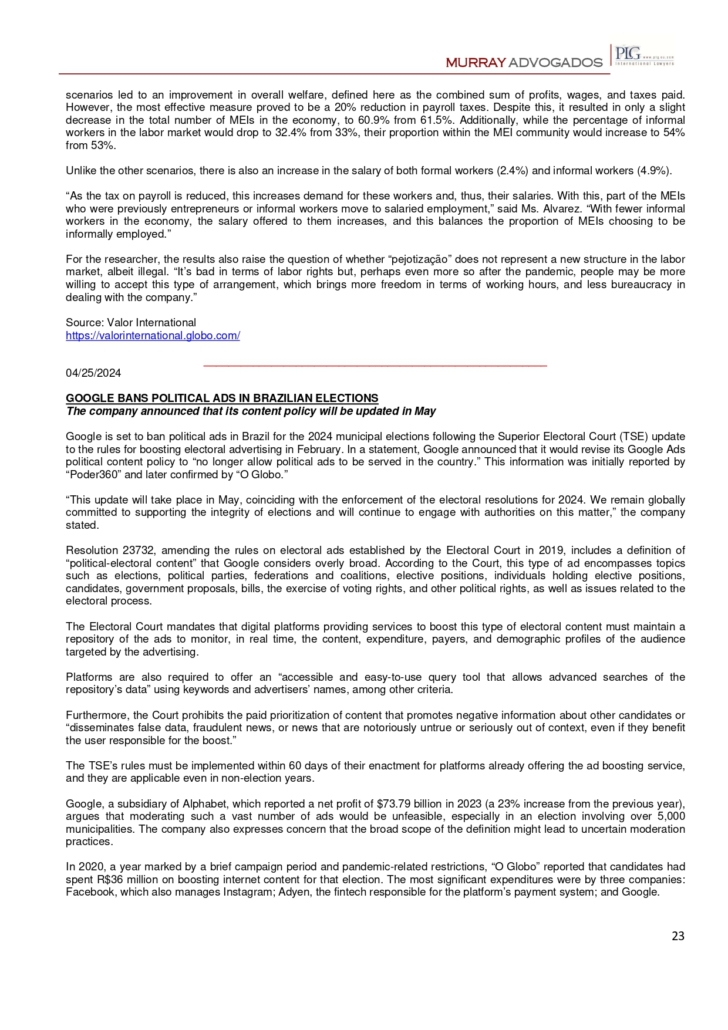
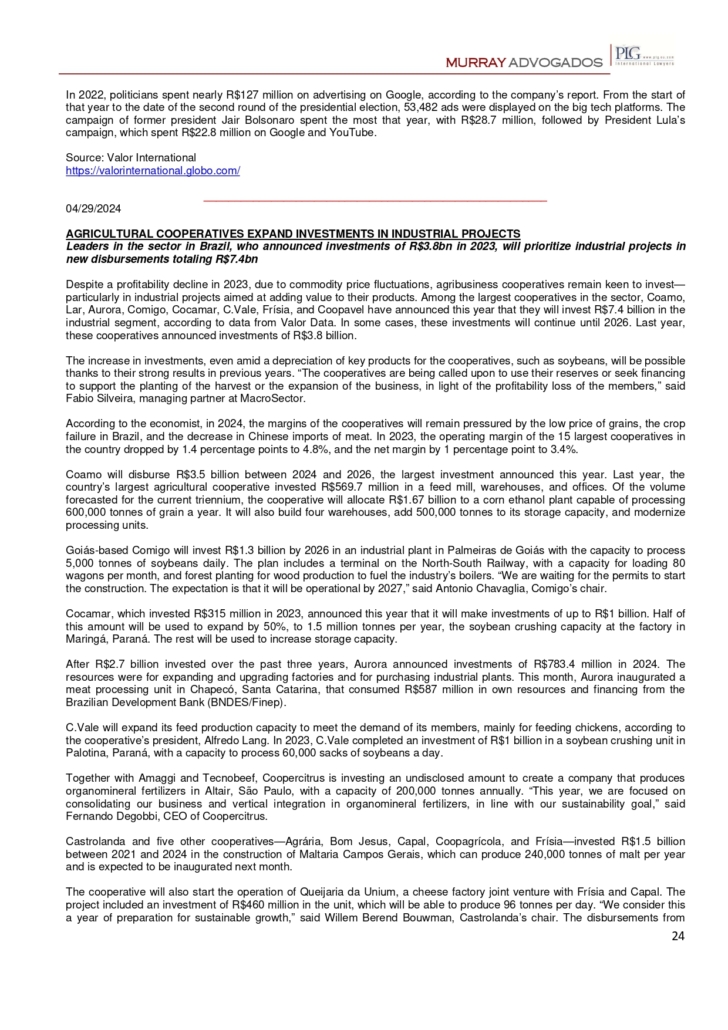
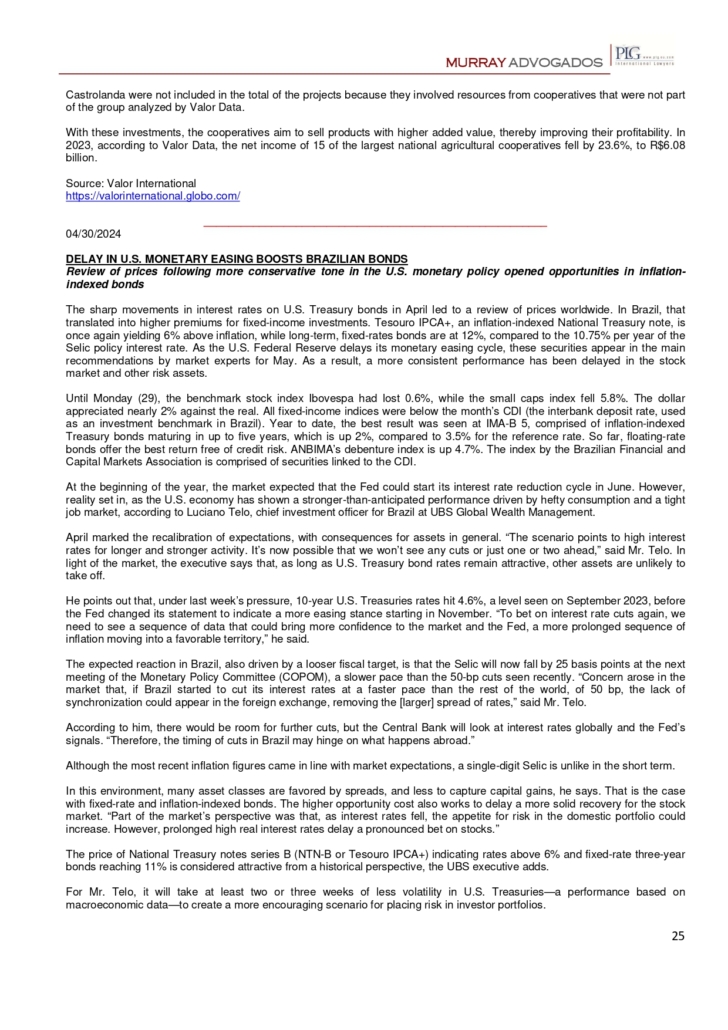
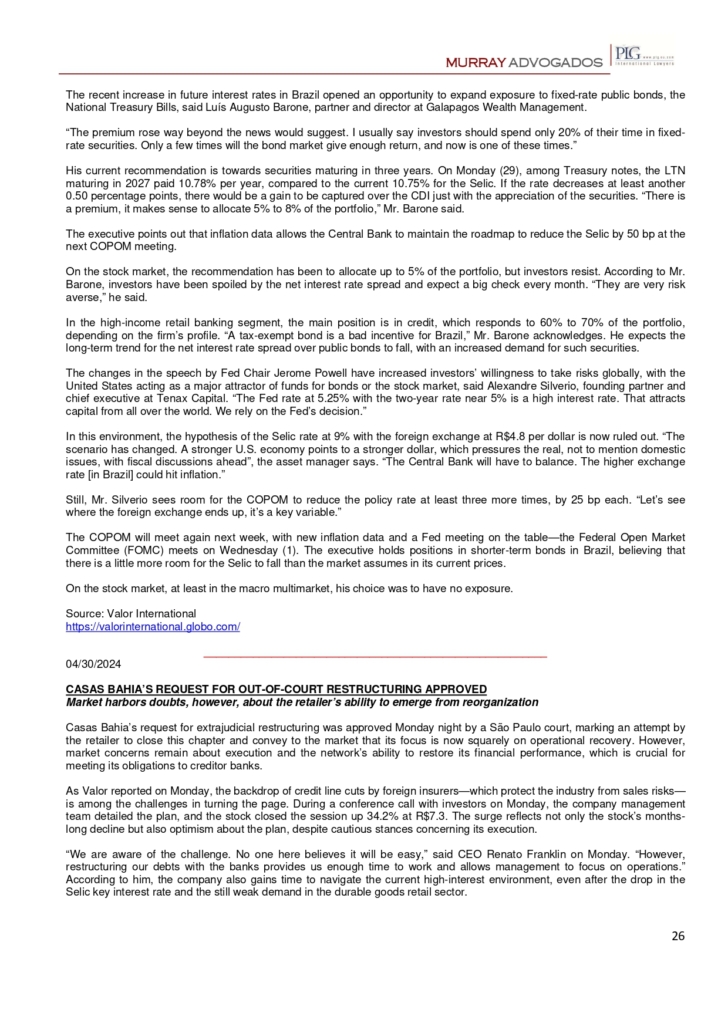

April 2024



























04/30/2024
/i.s3.glbimg.com/v1/AUTH_37554604729d4b2f9f3eb9ad8a691345/internal_photos/bs/2024/e/S/Kz2yjZTRGsaUnAL3JrgQ/290424kevincheneeduardoassad019.jpg)
Kevin Chen and Eduardo Assad — Foto: Rogerio Vieira/Valor
At a time when China is increasing the number of Brazilian slaughterhouses authorized to sell beef to the country, a survey conducted in Beijing and Shanghai reveals that some Chinese consumers are willing to pay more for the product, provided it is not linked to deforestation in the Amazon.
The research, a collaboration between the Chinese Academy of Social Sciences and FGV Agro of the Getulio Vargas Foundation, is supported by the American NGO The Nature Conservancy. Despite the small sample size of consumers who buy Brazilian beef in China—only 720 were interviewed in the country’s two largest cities—the results surprised researchers. On average, respondents indicated they would pay 22.5% more than the current price for Brazilian meat if it came with assurances that it was sourced from cattle raised in zero-deforestation areas. Currently, a kilo (about 2.2 pounds) of tenderloin reaches Chinese consumers at prices ranging from about $40 to $70.
Last year, Brazilian beef exports totaled $5.73 billion—almost 1.2 million tonnes. Brazil accounts for about 60% of the beef imported by China, which is Brazil’s largest beef importer. In March, China authorized 38 more Brazilian meatpacking plants to supply its market, most of them beef producers. This increases the total number of Brazilian meat plants (beef, poultry, and pork) authorized to sell to China to 144.
Kevin Chen, a Chinese academic and member of Zhejiang University, suggests that deforestation-free Brazilian meat could potentially be sold in Chinese markets with a seal confirming its traceability. Mr. Chen is in Brazil this week for meetings and to present details of the research at an event in São Paulo on Tuesday (30).
Eduardo Assad, a researcher at FGV Agro, notes that Brazil’s meat industry has made strides in traceability. However, there remains a segment of producers who place less emphasis on sustainability, arguing that there will always be consumers who disregard this issue when purchasing. Mr. Assad believes that the survey of Chinese consumers supports a stance he has advocated for years: “It’s not going to be the government [that pushes for change in production methods], nor a regulatory body. It’s going to be the market. This is already happening, albeit on a small scale, but it will explode when China agrees to pay more for sustainable meat.”
Discussing the idea of a future label, Mr. Chen cautions against appearing naive: “I’m not saying that a label of this kind will solve all the problems,” he remarked. However, he adds that there is a possibility that Chinese consumers would agree to pay extra to ensure they are not contributing to deforestation on the other side of the world. “Research shows that this is feasible. Both the industry and the government need to take note of this.”
Mr. Chen is an influential voice in the Chinese government on issues related to sustainability and food. And there is a marked difference between the path he is proposing in China and that adopted by the European Union. The Europeans have approved rules that will prevent several products from entering the bloc if they don’t get the green light from a control and auditing system.
“We don’t want a future seal system to be mandatory. We want it to be voluntary. When it’s mandatory, whether it’s a good policy or not, it becomes a controversial issue. If it’s voluntary, we let the market decide,” said Mr. Chen.
Fernando Sampaio, Sustainability Director of the Brazilian Meat Industries Association (ABIEC), says that the country has the potential to produce more in smaller areas and that the market is the driving force to increase this efficiency.
Regarding deforestation, the ABIEC is talking about the need for more control measures on the part of the state as well as the private sector. One of the weak links in the country’s meat chain continues to be indirect animal suppliers. These are farmers who don’t sell cattle to meatpackers but who supply animals to farms that have contracts with the industry. “The issue is that we don’t have any information about these indirect suppliers,” explained Mr. Sampaio.
Despite the results of the survey, Mr. Chen says that today, consumers and importers in China don’t consider it a problem that they don’t have enough information about meat traceability. “At the moment, it’s not [an issue for consumers]. But it will be in the future. For a few reasons: one is that the international community is paying attention to the issue of deforestation and so is China, which imports a lot of products from Brazil. This has become an important concern.”
*Por Marcos de Moura e Souza — São Paulo
Source: Valor International
04/30/2024
/i.s3.glbimg.com/v1/AUTH_37554604729d4b2f9f3eb9ad8a691345/internal_photos/bs/2024/e/M/AJpE0WT7y4XRYiwymzeQ/120324renatofranklin005.jpg)
Renato Franklin — Foto: Rogerio Vieira/Valor
Casas Bahia’s request for extrajudicial restructuring was approved Monday night by a São Paulo court, marking an attempt by the retailer to close this chapter and convey to the market that its focus is now squarely on operational recovery. However, market concerns remain about execution and the network’s ability to restore its financial performance, which is crucial for meeting its obligations to creditor banks.
As Valor reported on Monday, the backdrop of credit line cuts by foreign insurers—which protect the industry from sales risks—is among the challenges in turning the page. During a conference call with investors on Monday, the company management team detailed the plan, and the stock closed the session up 34.2% at R$7.3. The surge reflects not only the stock’s months-long decline but also optimism about the plan, despite cautious stances concerning its execution.
“We are aware of the challenge. No one here believes it will be easy,” said CEO Renato Franklin on Monday. “However, restructuring our debts with the banks provides us enough time to work and allows management to focus on operations.” According to him, the company also gains time to navigate the current high-interest environment, even after the drop in the Selic key interest rate and the still weak demand in the durable goods retail sector.
The plan only involves unsecured debts with financial sector creditors. Suppliers and employees are not part of the deal, as it is not a court-supervised reorganization that encompasses all liabilities.
Under the proposal, the renegotiated debt with these creditors pertains to four bond issues and one Bank Credit Bill, totaling R$4.1 billion, with extended terms from 22 months to 72 months, including a two-and-a-half-year grace period for the principal. This arrangement reduces cash outflow through 2027 to R$500 million from R$4.8 billion.
The debt will be converted into a debenture issue of R$4.1 billion, with two series (part can be converted into shares). At the end of 72 months, the chain expects to save R$60 million annually in debt interest.
Banco do Brasil and Bradesco hold 54.5% of this liability and have already approved the plan, in negotiations that have been ongoing since mid-last year. Therefore, the restructuring request and the 159-page plan were submitted last Sunday to the 1st Bankruptcy and Judicial Recovery Court of São Paulo and were accepted early Monday evening. Despite being an out-of-court reorganization, the court must review the request.
The expectation is for a “cleaner” first quarter of 2024, said Mr. Franklin, without the burden of maturities, with operational issues better addressed. The retailer has been in operational restructuring since the beginning of 2023.
Even with this expectation, there are still some issues on the company’s table that need to evolve. Casas Bahia had problems with product supply from major manufacturers in categories such as appliances and electronics at the end of last year and the beginning of this year when it sought to replenish stocks. This reflected a reduction in lines from foreign credit insurers and suppliers.
According to sources, the tighter credit situation continued at least until February. Negotiations are ongoing in search of normalization, but this credit flow is still not ideal, in the view of the management board. “If we had the lines of credit, we would have sold more [in recent months],” said a source.
No major foreign supplier, such as Whirlpool, Samsung, LG, and Motorola, closes a deal to supply to national retailers without insurance coverage of some percentage of the sale. The crisis in the Americanas retail chain made insurers more selective.
The recovery plan and the recent improvement in the network’s cash generation may create space for normalization of these lines, believes a person close to the retailer. In November, a rating downgrade of Casas Bahia by S&P helped reduce this credit flow.
Regarding the deal with Bradesco and Banco do Brasil, the institutions wanted to definitively remove the “Casas Bahia risk” from the table, Valor has learned. The idea was to move away from temporary solutions, which would push the issue a year or two forward, to something more “definitive,” said a source.
In February, there was a debt restructuring anchored by Bradesco and BB, but with difficulties for the group to raise new funds, and with short-term bond maturities, the chain had to return to the negotiating table. More than R$1.5 billion in debentures with the banks were due this year.
From the banks’ perspective, piecemeal renegotiation solutions “here and there” would only delay a stronger dose of medicine, people familiar with the talks say. “If a broader agreement were delayed too much, the timing that still existed could be lost, and then only a court-supervised reorganization plan, which is the worst scenario, would resolve it,” said a creditor.
In negotiations with the institutions, one of the issues demanded by the banks concerned advancing the migration of the Direct Consumer Credit Line (CDCI) to the Credit Rights Investment Fund (FIDC), Valor has learned. The CDCI places the chain as responsible for settling customer financing installments with the banks. In the FIDC, the risk is diluted across thousands of consumer transactions. This migration to the FIDC was already under negotiation last year but was delayed and did not materialize. Now, this must progress.
According to the retailer, the priority from now on is the recovery of results. Focuses include improving gross margin, offering more services in stores, and gaining market share with a more accelerated sales recovery, said Mr. Franklin.
Analysts consider the out-of-court reorganization plan positive due to the substantial renegotiation of values, but highlight the risk of dispersion of current partners (Michael Klein is the largest one) after the issuance of debentures converted into shares. The restructuring was orchestrated by Lazard and the Pinheiro Neto law firm.
*Por Adriana Mattos — São Paulo
Source: Valor International
An increase of 3.9% compared to the last three months of 2023, according to data from the RGF Monitor
04/30/2024
/i.s3.glbimg.com/v1/AUTH_37554604729d4b2f9f3eb9ad8a691345/internal_photos/bs/2024/K/p/Jo03EOSZaFq5kqe03oSQ/250823rodrigogallegos014.jpg)
Rodrigo Gallegos — Foto: Rogerio Vieira/Valor
The number of companies in court-ordered reorganization in Brazil continues to rise. By the end of the first quarter, 4,203 companies were under court supervision to renegotiate debts with creditors. This marks a 3.9% increase compared to the last quarter of 2023, according to data from the RGF Judicial Recovery Monitor, conducted by consultancy RGF & Associados and shared exclusively with Valor.
The monitoring reveals that 1.87 out of every 1,000 small, medium, and large corporations were undergoing restructuring, from a total of 2.3 million. This ratio is the highest since RGF began compiling the figures in the second quarter of 2023. The situation is particularly severe in the Midwest region of the country, where three out of every thousand companies are facing reorganization. In the state of Goiás, the figure approaches five.
The concentration of these cases in certain locations is not random. Among the five segments facing the most significant financial challenges, three are tied to the agribusiness sector, which is predominant in the region. Leading the list is sugar cane cultivation, with 29 companies in reorganization per one thousand, followed by dairy production (15.88), road and railroad construction (15.05), municipal public transportation (15.03), and soybean cultivation (11.83).
In the January-March period, notable cases of companies entering reorganization include the DIA grocery stores chain in São Paulo, with a debt of R$1.1 billion; OSX, one of businessman Eike Batista’s companies in Rio de Janeiro, with liabilities of R$7.94 billion; and the Libra Bioenergia Group, an ethanol producer in Mato Grosso, owing R$534.7 million. Meanwhile, Schumann Móveis e Eletrodomésticos, a chain from Santa Catarina, exited the process.
According to restructuring and judicial recovery specialist Rodrigo Gallegos, a partner at RGF, the figures still reflect the aftermath of the COVID-19 pandemic. “With the rise in interest rates, companies began to lose cash flow, and financial stability ended in 2023,” he explains. He also mentions the impact of the Americanas case, which entered reorganization early last year and caused “all financial institutions to hold back on credit.”
Mr. Gallegos anticipates that the effects of the pandemic will continue to be felt in the coming months but should improve towards the end of the year and the beginning of 2025. “If everything remains as it is today, with the economy improving, the government’s efforts, and the Central Bank gradually reducing interest rates, these are excellent signs for the cost of debt to start declining.”
Despite these statistics, RGF experts observe a slowdown in the rate of companies in this situation, indicating that the growth is not exponential. “From the third to the fourth quarter, we saw a significant increase, both in absolute terms and in the index. It’s still growing, but at a slower pace than last year,” notes Roberta Gonzaga, a consultant specializing in restructuring at RGF.
The absolute number of companies entering judicial reorganization was 17% lower in the last quarter compared to the previous period—296 in 2024 versus 357 in the fourth quarter of 2023. However, as fewer companies exited the process at the start of the year, the total number of companies in this predicament continues to rise. There were 196 exits from court supervision at the end of last year but only 138 at the beginning of this year. Under the Judicial Reorganization and Bankruptcy Act (Law 11101/2005), judicial protection lasts two years from the date the procedure is authorized, a period that the judge can extend.
Ms. Gonzaga highlights a positive development in the three-percentage point increase in the category of companies that have resumed normal operations after exiting legal proceedings. It rose from 60% to 63% and has consistently remained above half. In the third quarter of 2023, it was at 55%.
According to lawyer Cinthia de Lamare, a partner in the restructuring and insolvency department at the law firm Cescon Barrieu, another discreet reason for the continued rise in judicial reorganizations is their evolving perception. They are no longer viewed solely as a means to renegotiate debtor debts but also as a business environment.
“Within court-ordered reorganizations, we see everything from financing with debtor-in-possession at more attractive rates for investors to the sale of assets and corporate operations on the capital market. It all signals to the market that the process can be an appealing solution for viable companies,” she explained, noting a paradigm shift.
Ms. Lamare also points out that the greater involvement of creditors has made the tool more sophisticated, enhanced by the reform of Law 14112 in 2020, which has bolstered entrepreneurs’ confidence in seeking judicial reorganization. “Today we have clearer rules, and the court-supervised recovery plan itself is crafted by many hands, which makes the recovery more successful.”
The RGF Judicial Recovery Monitor, which utilizes data from the Federal Revenue Service, only considers judicial recoveries that have already been approved by the courts, not applications. Micro-entrepreneurs and government companies are excluded from the database, as are subsidiaries, so only the parent company is considered.
In the first quarter, according to data collected by Serasa Experian, 501 requests for judicial reorganization were submitted, and 427 were granted. The difference in data results from the disparate research methodologies. While RGF uses data from the Internal Revenue Service, Serasa, which has been tracking the data since 2005, when the historical series began, gathers information from courthouses, bankruptcy courts
and official and state court gazettes.
*Por Marcela Villar — São Paulo
Source: Valor International
04/30/2024
/i.s3.glbimg.com/v1/AUTH_37554604729d4b2f9f3eb9ad8a691345/internal_photos/bs/2024/e/e/L7yRVjTGCQMm1JKO2RAA/301123lucianotelo002.jpg)
Luciano Telo — Foto: Rogerio Vieira/Valor
The sharp movements in interest rates on U.S. Treasury bonds in April led to a review of prices worldwide. In Brazil, that translated into higher premiums for fixed-income investments. Tesouro IPCA+, an inflation-indexed National Treasury note, is once again yielding 6% above inflation, while long-term, fixed-rates bonds are at 12%, compared to the 10.75% per year of the Selic policy interest rate. As the U.S. Federal Reserve delays its monetary easing cycle, these securities appear in the main recommendations by market experts for May. As a result, a more consistent performance has been delayed in the stock market and other risk assets.
Until Monday (29), the benchmark stock index Ibovespa had lost 0.6%, while the small caps index fell 5.8%. The dollar appreciated nearly 2% against the real. All fixed-income indices were below the month’s CDI (the interbank deposit rate, used as an investment benchmark in Brazil). Year to date, the best result was seen at IMA-B 5, comprised of inflation-indexed Treasury bonds maturing in up to five years, which is up 2%, compared to 3.5% for the reference rate. So far, floating-rate bonds offer the best return free of credit risk. ANBIMA’s debenture index is up 4.7%. The index by the Brazilian Financial and Capital Markets Association is comprised of securities linked to the CDI.
At the beginning of the year, the market expected that the Fed could start its interest rate reduction cycle in June. However, reality set in, as the U.S. economy has shown a stronger-than-anticipated performance driven by hefty consumption and a tight job market, according to Luciano Telo, chief investment officer for Brazil at UBS Global Wealth Management.
April marked the recalibration of expectations, with consequences for assets in general. “The scenario points to high interest rates for longer and stronger activity. It’s now possible that we won’t see any cuts or just one or two ahead,” said Mr. Telo. In light of the market, the executive says that, as long as U.S. Treasury bond rates remain attractive, other assets are unlikely to take off.
He points out that, under last week’s pressure, 10-year U.S. Treasuries rates hit 4.6%, a level seen on September 2023, before the Fed changed its statement to indicate a more easing stance starting in November. “To bet on interest rate cuts again, we need to see a sequence of data that could bring more confidence to the market and the Fed, a more prolonged sequence of inflation moving into a favorable territory,” he said.
The expected reaction in Brazil, also driven by a looser fiscal target, is that the Selic will now fall by 25 basis points at the next meeting of the Monetary Policy Committee (COPOM), a slower pace than the 50-bp cuts seen recently. “Concern arose in the market that, if Brazil started to cut its interest rates at a faster pace than the rest of the world, of 50 bp, the lack of synchronization could appear in the foreign exchange, removing the [larger] spread of rates,” said Mr. Telo.
According to him, there would be room for further cuts, but the Central Bank will look at interest rates globally and the Fed’s signals. “Therefore, the timing of cuts in Brazil may hinge on what happens abroad.”
Although the most recent inflation figures came in line with market expectations, a single-digit Selic is unlike in the short term.
In this environment, many asset classes are favored by spreads, and less to capture capital gains, he says. That is the case with fixed-rate and inflation-indexed bonds. The higher opportunity cost also works to delay a more solid recovery for the stock market. “Part of the market’s perspective was that, as interest rates fell, the appetite for risk in the domestic portfolio could increase. However, prolonged high real interest rates delay a pronounced bet on stocks.”
The price of National Treasury notes series B (NTN-B or Tesouro IPCA+) indicating rates above 6% and fixed-rate three-year bonds reaching 11% is considered attractive from a historical perspective, the UBS executive adds.
For Mr. Telo, it will take at least two or three weeks of less volatility in U.S. Treasuries—a performance based on macroeconomic data—to create a more encouraging scenario for placing risk in investor portfolios.
The recent increase in future interest rates in Brazil opened an opportunity to expand exposure to fixed-rate public bonds, the National Treasury Bills, said Luís Augusto Barone, partner and director at Galapagos Wealth Management.
“The premium rose way beyond the news would suggest. I usually say investors should spend only 20% of their time in fixed-rate securities. Only a few times will the bond market give enough return, and now is one of these times.”
His current recommendation is towards securities maturing in three years. On Monday (29), among Treasury notes, the LTN maturing in 2027 paid 10.78% per year, compared to the current 10.75% for the Selic. If the rate decreases at least another 0.50 percentage points, there would be a gain to be captured over the CDI just with the appreciation of the securities. “There is a premium, it makes sense to allocate 5% to 8% of the portfolio,” Mr. Barone said.
The executive points out that inflation data allows the Central Bank to maintain the roadmap to reduce the Selic by 50 bp at the next COPOM meeting.
On the stock market, the recommendation has been to allocate up to 5% of the portfolio, but investors resist. According to Mr. Barone, investors have been spoiled by the net interest rate spread and expect a big check every month. “They are very risk averse,” he said.
In the high-income retail banking segment, the main position is in credit, which responds to 60% to 70% of the portfolio, depending on the firm’s profile. “A tax-exempt bond is a bad incentive for Brazil,” Mr. Barone acknowledges. He expects the long-term trend for the net interest rate spread over public bonds to fall, with an increased demand for such securities.
The changes in the speech by Fed Chair Jerome Powell have increased investors’ willingness to take risks globally, with the United States acting as a major attractor of funds for bonds or the stock market, said Alexandre Silverio, founding partner and chief executive at Tenax Capital. “The Fed rate at 5.25% with the two-year rate near 5% is a high interest rate. That attracts capital from all over the world. We rely on the Fed’s decision.”
In this environment, the hypothesis of the Selic rate at 9% with the foreign exchange at R$4.8 per dollar is now ruled out. “The scenario has changed. A stronger U.S. economy points to a stronger dollar, which pressures the real, not to mention domestic issues, with fiscal discussions ahead”, the asset manager says. “The Central Bank will have to balance. The higher exchange rate [in Brazil] could hit inflation.”
Still, Mr. Silverio sees room for the COPOM to reduce the policy rate at least three more times, by 25 bp each. “Let’s see where the foreign exchange ends up, it’s a key variable.”
The COPOM will meet again next week, with new inflation data and a Fed meeting on the table—the Federal Open Market Committee (FOMC) meets on Wednesday (1). The executive holds positions in shorter-term bonds in Brazil, believing that there is a little more room for the Selic to fall than the market assumes in its current prices.
On the stock market, at least in the macro multimarket, his choice was to have no exposure.
*Por Adriana Cotias — São Paulo
Source: Valor International
04/29/2024
/i.s3.glbimg.com/v1/AUTH_37554604729d4b2f9f3eb9ad8a691345/internal_photos/bs/2024/4/X/uXsaUMTYia74FDMPERlg/120324renatofranklin008.jpg)
Renato Franklin — Foto: Rogerio Vieira/Valor
The Casas Bahia group informed the market on Sunday (28) that it has reached an out-of-court reorganization agreement with its main creditors, Banco do Brasil and Bradesco, to carry out a reprofiling of the entire company’s debt.
The payment term for the R$4.1 billion of gross debt—in updated values—was extended to 72 months from 22 months, with a 1.5 percentage points reduction to the average cost, which will now be the CDI plus 1.2% per year. A grace period of 24 months to pay interest and 30 months to pay the principal has been set. The CDI, or interbank deposit rate, is an investment benchmark in the Brazilian financial system.
With the changes, the company will no longer have to disburse R$4.3 billion by 2027.
The two banks hold 54.5% of Casas Bahia’s debt and have agreed to the reprofiling. As a result, the other creditors, which are pulverized, will automatically follow suit, according to Casas Bahia CEO Renato Franklin. “When you have the approval of more than 50% [of creditors], it’s automatic. That is the advantage of having an out-of-court agreement.”
According to him, the retailer’s lawyers are optimistic about the approval. The out-of-court reorganization request was filed on Sunday (28) and should be analyzed by the courts for up to a week. After that, there are 30 days to raise objections before ratification. Once these steps have been completed, the group can implement the out-of-court reorganization and replace the current financial debt with new instruments.
The debt will be swapped into debentures of R$4.1 billion, with two series. The first one, representing 37% of the amount, has a rate of the CDI plus 1.5% per year. The second series has two versions: one includes “partner” creditors, described as such either because they will maintain the current loan facility terms that are not in the reorganization or make new funds available to the group. They will be able to swap the debt into shares by Casas Bahia within 18 to 36 months.
The shareholders will have preemptive rights to avoid dilution. According to Mr. Franklin, Banco do Brasil and Bradesco fit into that category. Non-partner creditors, in turn, will not have that option. The rate for partner and non-partner creditors will be the CDI plus 1% per year.
The negotiation of the reorganization involves only unsecured financial debts. Labor and supplier issues are not included in the agreement. There is also no discount on the principal amount.
In February, Casas Bahia restructured part of its debt, amounting to R$1.5 billion. However, according to the CEO, the debt extension of 3 years obtained at that time was insufficient to solve the company’s problem. “It remained tight. Therefore, we were seeking to build something permanent.”
According to him, the business restructuring plan announced in August 2023 requires cash, as it involves layoffs and store closures. The debt pile has put pressure on the retailer and “tarnished” its image in the market. “It hinders the company’s valuation and some of its businesses,” the CEO said. With the reorganization, the company expects to improve its credit outlook and relationship with suppliers.
The agreement with creditors solves the financial part of Casas Bahia’s restructuring plan, Mr. Franklin says. The operational part remains unsolved.
The company has laid off 8,600 employees, including 42% of top management positions. There was a plan of closing 100 stores but the CEO says only 55 were closed. “We managed to recover the others by reducing rental costs.” No new “restructuring” layoffs are planned.
Also on the operational side, the company is expected to continue reviewing product assortment and pricing, which will become more dynamic, according to Mr. Franklin. There is also an effort to expand services—which includes offering insurance and extended warranties—, the new digital advertising platform, and a store-in-store model with supplier points of sale.
The company ended the fourth quarter with a net loss of R$1 billion. In 2023, the loss was R$2.6 billion, almost eight times the total recorded a year earlier. Net revenue fell 6.6% in the same period, to R$28.8 billion.
Mr. Franklin says the effects of the reorganization should be seen in the second quarter’s results. “We are very happy.”
*Por Ana Luiza Tieghi — São Paulo
Source: Valor International
04/29/2024
/i.s3.glbimg.com/v1/AUTH_37554604729d4b2f9f3eb9ad8a691345/internal_photos/bs/2024/d/t/lV0mBESaqCUlFELP9kBA/fernando-degobbi-da-coopercitrus-divulgacao.png)
Fernando Degobbi — Foto: Divulgação
Despite a profitability decline in 2023, due to commodity price fluctuations, agribusiness cooperatives remain keen to invest—particularly in industrial projects aimed at adding value to their products. Among the largest cooperatives in the sector, Coamo, Lar, Aurora, Comigo, Cocamar, C.Vale, Frísia, and Coopavel have announced this year that they will invest R$7.4 billion in the industrial segment, according to data from Valor Data. In some cases, these investments will continue until 2026. Last year, these cooperatives announced investments of R$3.8 billion.
The increase in investments, even amid a depreciation of key products for the cooperatives, such as soybeans, will be possible thanks to their strong results in previous years. “The cooperatives are being called upon to use their reserves or seek financing to support the planting of the harvest or the expansion of the business, in light of the profitability loss of the members,” said Fabio Silveira, managing partner at MacroSector.
According to the economist, in 2024, the margins of the cooperatives will remain pressured by the low price of grains, the crop failure in Brazil, and the decrease in Chinese imports of meat. In 2023, the operating margin of the 15 largest cooperatives in the country dropped by 1.4 percentage points to 4.8%, and the net margin by 1 percentage point to 3.4%.
Coamo will disburse R$3.5 billion between 2024 and 2026, the largest investment announced this year. Last year, the country’s largest agricultural cooperative invested R$569.7 million in a feed mill, warehouses, and offices. Of the volume forecasted for the current triennium, the cooperative will allocate R$1.67 billion to a corn ethanol plant capable of processing 600,000 tonnes of grain a year. It will also build four warehouses, add 500,000 tonnes to its storage capacity, and modernize processing units.
Goiás-based Comigo will invest R$1.3 billion by 2026 in an industrial plant in Palmeiras de Goiás with the capacity to process 5,000 tonnes of soybeans daily. The plan includes a terminal on the North-South Railway, with a capacity for loading 80 wagons per month, and forest planting for wood production to fuel the industry’s boilers. “We are waiting for the permits to start the construction. The expectation is that it will be operational by 2027,” said Antonio Chavaglia, Comigo’s chair.
Cocamar, which invested R$315 million in 2023, announced this year that it will make investments of up to R$1 billion. Half of this amount will be used to expand by 50%, to 1.5 million tonnes per year, the soybean crushing capacity at the factory in Maringá, Paraná. The rest will be used to increase storage capacity.
After R$2.7 billion invested over the past three years, Aurora announced investments of R$783.4 million in 2024. The resources were for expanding and upgrading factories and for purchasing industrial plants. This month, Aurora inaugurated a meat processing unit in Chapecó, Santa Catarina, that consumed R$587 million in own resources and financing from the Brazilian Development Bank (BNDES/Finep).
C.Vale will expand its feed production capacity to meet the demand of its members, mainly for feeding chickens, according to the cooperative’s president, Alfredo Lang. In 2023, C.Vale completed an investment of R$1 billion in a soybean crushing unit in Palotina, Paraná, with a capacity to process 60,000 sacks of soybeans a day.
Together with Amaggi and Tecnobeef, Coopercitrus is investing an undisclosed amount to create a company that produces organomineral fertilizers in Altair, São Paulo, with a capacity of 200,000 tonnes annually. “This year, we are focused on consolidating our business and vertical integration in organomineral fertilizers, in line with our sustainability goal,” said Fernando Degobbi, CEO of Coopercitrus.
Castrolanda and five other cooperatives—Agrária, Bom Jesus, Capal, Coopagrícola, and Frísia—invested R$1.5 billion between 2021 and 2024 in the construction of Maltaria Campos Gerais, which can produce 240,000 tonnes of malt per year and is expected to be inaugurated next month.
The cooperative will also start the operation of Queijaria da Unium, a cheese factory joint venture with Frísia and Capal. The project included an investment of R$460 million in the unit, which will be able to produce 96 tonnes per day. “We consider this a year of preparation for sustainable growth,” said Willem Berend Bouwman, Castrolanda’s chair. The disbursements from Castrolanda were not included in the total of the projects because they involved resources from cooperatives that were not part of the group analyzed by Valor Data.
With these investments, the cooperatives aim to sell products with higher added value, thereby improving their profitability. In 2023, according to Valor Data, the net income of 15 of the largest national agricultural cooperatives fell by 23.6%, to R$6.08 billion.
*Por Cibelle Bouças — Belo Horizonte
Source: Valor International
04/29/2024
/i.s3.glbimg.com/v1/AUTH_37554604729d4b2f9f3eb9ad8a691345/internal_photos/bs/2021/g/B/b1sBreSfCqz7qYmRIpAg/151221marcelo040.jpg)
Marcelo Noronha — Foto: Ana Paula Paiva/Valor
Large publicly-traded banks are expected to see new profit growth in the first quarter, continuing the trends observed in recent periods: a slight decrease in defaults and moderate credit growth. However, the focus is likely to shift to the institutions’ expectations for the rest of the year. Despite recent guidance, the external environment has become more clouded, particularly regarding the direction of U.S. interest rates, domestic fiscal issues, and the uncertain performance of economic activities, especially in agribusiness.
A survey by Valor, covering nine companies, indicates that Itaú Unibanco, Banco do Brasil, Bradesco, and Santander are projected to achieve a combined profit of R$25.6 billion. This represents a 7.1% increase from the fourth quarter and a 9.5% rise compared to the first quarter of 2023. Itaú is expected to continue setting new records, while Banco do Brasil faces concerns about potential issues in agribusiness. Santander is likely to continue its recovery trajectory from the previous quarter, and Bradesco will remain under scrutiny due to investor expectations about its restructuring process.
Analysts from J.P. Morgan generally believe concerns about defaults are receding. However, they are keen to see the outcomes of renegotiated credit figures, especially with the federal government’s Desenrola program—a federal initiative designed to help individuals renegotiate their debts under more favorable terms. Meanwhile, recent data from the Central Bank shows that credit was slightly weaker than expected in the first quarter. “For loan performance, we anticipate weak trends, despite some improvements in the origination of certain products, such as vehicle financing and payroll loans.”
XP analysts predict that portfolio growth will start slowly and pick up pace in the subsequent quarters. “The first quarter tends to be negatively impacted by seasonality, particularly for individuals.”
Goldman Sachs notes that although revenue trends may be subdued due to slower loan growth and weaker service seasonality at the year’s start, most banks should see a decrease in provisioning levels and a sequential reduction in expenses from the typically high levels of the fourth quarter. “Additionally, net interest income growth should remain strong year-on-year, maintaining resilient average ROEs at 18%.”
UBS highlights that capital generation could be a notable aspect of the quarter. While Itaú is expected to continue with excess capital—having announced an extraordinary dividend payment of R$11 billion in February—Bradesco and Santander might start experiencing some medium-term capital pressure.
Banco do Brasil is expected to report a profit of R$9.4 billion for the first quarter. The state-owned bank had been competing closely with Itaú in recent quarters, but it is now anticipated to be the only one to experience a decline compared to the fourth quarter. Previously, its subsidiary in Argentina, Banco Patagonia, significantly boosted the group’s results due to the peso’s maxi-devaluation, an event unlikely to be repeated to the same extent. Additionally, the very low effective tax rate is expected to increase slightly.
In any case, analysts will primarily focus on agribusiness, a crucial sector for Banco do Brasil (BB). While a significant impact on defaults is not yet anticipated, provisions in this sector may already be on the rise. According to the Santander CIB report, “Although we expect a slight increase in defaults in agribusiness, there should be a reduction in the corporate segment, keeping overall defaults virtually stable in the first quarter. However, we foresee significantly higher provisions year-on-year.”
XP analysts note, “We expect another quarter of robust growth in Banco do Brasil’s loan portfolio, probably aligning with the midpoint of its guidance (8% to 12%), despite recent concerns related to a stronger-than-expected slowdown in the agribusiness sector. BB seems to have managed to navigate this challenging scenario.”
Both BB and Bradesco are expected to face further queries from analysts regarding their strategies for Cielo, which is anticipated to progress in its delisting from the stock exchange in the coming months. Bradesco is expected to report a profit of R$3.9 billion, a sharp increase from the previous quarter, which saw higher provision expenses and an extraordinary R$570 million in restructuring costs, particularly in the branch network. In the first quarter’s financial report, the spotlight was on the announcement of the strategic plan by the new CEO, Marcelo Noronha. The focus now shifts to the initial signs of strategy implementation.
“After several quarters of lower-than-expected results, expectations for Bradesco are already low,” states UBS BB. “The recent improvement in asset quality has likely shifted investors’ focus away from this. We believe the emphasis will be on the dynamics of net interest income after the very weak numbers in the second half of last year, the capital position, and the pace of branch reductions.”
Genial’s analysts believe that although the current results are not very encouraging, the worst is over, and Bradesco’s profitability is expected to improve with the recovery of the credit cycle. “We believe that both the 2024 guidance and the restructuring plan reflect more conservative outcomes, taking into account the lessons learned from several years marked by overly optimistic guidances that failed to materialize.”
In the case of Santander, a profit of R$2.8 billion is projected, supported by a strong recovery both annually and quarterly. This result should benefit from lower provisions and an improved margin with the market, which is expected to turn positive after seven consecutive quarters in the red. While defaults may rise slightly, driven primarily by the performance of the renegotiated portfolio, the pace of provisions is expected to decrease. “Santander will show signs of improvement and solid growth in net income year-on-year, the best in the sector, albeit from a low base,” summarized Bank of America (BofA).
Itaú is set to continue breaking records, with projected profits of R$9.7 billion and a return on equity (ROE) close to 21%. Although negative seasonality in credit cards might slightly dampen the expansion of the portfolio and fee income—given the bank’s leading position in this market—it will not overshadow the overall positive results. “We expect a seasonal increase in short-term delinquency rates, with 90-day delinquency remaining stable. Meanwhile, provisions are expected to decrease by 6% in the quarter,” reported Goldman Sachs.
In a recent report, Citi said that guidance for Itaú’s cost of risk this year seemed too conservative. “Despite an expected reacceleration and higher risk in the portfolio, we believe the continued improvement in default formation could be a positive development throughout the year.”
Finally, Nubank is expected to post a profit of $393 million. BofA estimates that the bank will reach 98.5 million customers, with a 48% expansion of the credit portfolio, but says that profit may end up coming in slightly lower than expected due to the larger investments in Mexico. “We expect provisions to increase by 27% in the quarter, given the continued strong growth in loans, as well as a low comparison base, as the fourth quarter benefited from discounts related to Desenrola,” Goldman Sachs stated.
*Por Álvaro Campos — São Paulo
Source: Valor International
04/26/2024
/i.s3.glbimg.com/v1/AUTH_37554604729d4b2f9f3eb9ad8a691345/internal_photos/bs/2024/v/H/uNSSz8RcCqcNARM7HdqA/250822xp17.jpg)
Vitor Saraiva — Foto: Silvia Costanti/Valor
Contrary to the optimism at the end of last year, 2024 has begun weakly for stock offerings on the Brazilian stock exchange, marking the least active start in at least eight years in terms of financial volume. This year has seen six follow-ons from already listed companies, totaling R$4.9 billion, significantly bolstered by Energisa’s R$2.5 billion transaction. There’s a growing sentiment that the Brazilian market may experience its third consecutive off-year for initial public offerings (IPOs).
According to Valor’s calculations based on B3 data—Brazil’s stock exchange—the financial volume only includes local transactions, excluding Banco Inter’s offering on Nasdaq aimed at enhancing liquidity on the American stock exchange. Last year, market activity stalled following the public disclosure of a major corporate fraud involving retailer Americanas, halting business momentum in the first quarter. During the same period, the volume reached R$7.1 billion across four transactions, one of which involved Assaí, with Casino selling R$4 billion worth of shares to fulfill its creditor obligations. Since May, however, the market has seen increased activity, primarily from debt-laden companies.
This year, the standout offering is expected from Sabesp, which is undergoing a privatization process by the São Paulo government that could generate around R$20 billion. The plan aims to attract a reference investor to acquire 15% of the company, with ongoing evaluations of how to navigate the high market volatility. Another significant transaction is Eletrobras’s sale of Isa Cteep shares, potentially raising R$4 billion, contingent on improved market conditions.
To date, this year’s total only surpasses that of 2016, when the volume was confined to R$3.49 billion across four transactions between January and April—a period notably affected by high market volatility and President Dilma Rousseff’s impeachment. On the contrary, the most successful start was in 2021, when the Brazilian stock exchange hosted 33 offers in the first four months alone, totaling a record R$54.9 billion, buoyed by substantial global liquidity, and that period included 22 IPOs, a stark contrast to the recent trend.
The year’s weak start has disappointed investment banks and companies eager to enter the stock market. Expectations for U.S. interest rate cuts have been repeatedly deferred as new data points to a persistently robust American economy, suggesting a prolonged period of high rates. This delay is pushing back the anticipated opening of the IPO window.
Additionally, concerns over Brazil’s fiscal health are impacting market transactions, prompting listed companies to delay raising capital to avoid diluting shareholder value. Bruno Saraiva, co-head of Bank of America’s investment bank in Brazil, notes that the ongoing delay in U.S. rate cuts has dampened the market’s recovery hopes, deviating from initial forecasts of five Federal Reserve rate reductions to now just one expected in December. This adjustment follows reports of persistent inflation, complicating predictions for deal timing. “Today, it’s harder to know when there will be a deal,” he remarks. “When rates start to decline in the U.S., emerging markets will benefit.”
Vitor Saraiva, head of equity capital markets at XP, acknowledges that U.S. inflation data has altered projections, yet he remains hopeful for a few year-end IPOs, contingent on sustained expectations for Fed rate cuts. “Today, if there are [IPOs], it will be towards the end of the year,” he asserts.
Despite ongoing volatility, the secondary offering by Boa Safra, which attracted solid market interest, demonstrates that high-performing companies can successfully raise capital. “Good companies with compelling narratives earn credibility in the market,” he explains.
Marcello Lo Re, head of Latin American equity capital markets at Morgan Stanley, observes a resurgence in market activity in other Latin American nations, particularly Mexico, where the financial institution is increasingly focusing due to rising capital market activities. In Brazil, attention remains fixed on the latter half of the year, particularly as investors begin considering the prospects for 2025 from September onwards.
*Por Fernanda Guimarães — São Paulo
Source: Valor International
04/26/2024
/i.s3.glbimg.com/v1/AUTH_37554604729d4b2f9f3eb9ad8a691345/internal_photos/bs/2024/7/e/mt1CYKS4m0f9XvGoaaag/231027citi018.jpg)
Leonardo Porto — Foto: Leonardo Rodrigues/Valor
The unexpectedly robust job market performance has surprised economists and is good news for economic activity. However, it is also a major concern for the Central Bank. While a heated job market reflects a buoyant economy and means more income and consumption, a tight labor market can generate greater inflationary pressures and slow the pace of interest rate cuts, economists say.
Despite other factors, such as changes in fiscal targets and monetary policy directions in the United States, adding pressure to the decisions of the Monetary Policy Committee (COPOM), low unemployment and rising income continue to pose a problem for the Central Bank in reducing the Selic key interest rate.
In a report sent to clients recently, Citi Brazil noted that the current unemployment rate of 7.6%—the lowest since the first quarter of 2015—and real wage growth indicate the restrictive nature of labor market conditions in the country.
“The already tight labor market conditions, coupled with the view that growth is heading for acceleration, are likely to increasingly restrict the disinflation process,” wrote economists Leonardo Porto, Paulo Lopes, and Thais Ortega. “This outlook will likely motivate the COPOM to halt the interest rate reduction cycle not only sooner but also at a higher level.”
In particular, the pace of wage increases is not in line with productivity, said Mr. Porto, chief economist at Citi Brazil. “If wages rise in line with productivity, it does not generate inflationary pressures. However, if this increase is not anchored, there are potential risks of inflationary pressures emerging,” he added.
“When we look at data from the National Household Sample Survey (PNAD), we see a nominal wage increase of 9% and a real increase of 4.3%. These numbers are well above any productivity estimate in Brazil.”
A warning, the economist notes, is the sign of economic acceleration, which should further heat the job market.
After stagnation in the second half of 2023, Citi estimates GDP growth of 0.4% in the first quarter and 0.6% in the second, compared to the previous quarter, driven by domestic demand, particularly from household consumption and investment. For the year, the bank expects GDP growth of 1.5%. The unemployment rate, meanwhile, should stand at 7.5% this year, compared to 8% in 2023.
“In these conditions, the labor market is expected to strengthen even further in the future, with lower unemployment rates, pointing to an even smaller output gap [the difference between current GDP and potential GDP],” the report said.
These risks are added to a scenario of unanchored disinflation expectations in the medium and long term, which creates an additional limitation for the Central Bank.
In the Focus survey released on Tuesday, the inflation expectation for 2024 rose to 3.73% from 3.71% in one week. For 2025, the projection increased to 3.60% from 3.56%.
In addition to sustaining high service inflation, the tight job market is expected to lead to higher goods inflation, according to Citi. The bank projects a 4% rise in the benchmark inflation index (IPCA) this year.
Mr. Porto expects a Selic cut to 10% at the COPOM meeting in June. However, there are doubts about whether this projection should be recalibrated. This is because, in recent days, other risks to the interest rate cut cycle have begun to materialize.
Domestically, the change in the fiscal target has raised an alert. Internationally, there have been shifts in U.S. monetary policy, with the Federal Reserve facing greater inflationary pressures—in March, the consumer price index CPI advanced 3.5% on an annual basis, against an expectation of 3.4%.
As a result, there has been a repricing of U.S. monetary policy, said Rodolfo Margato, an economist at XP. At the beginning of the year, the market had priced in at least six interest rate cuts over the year. Now, there is uncertainty about the next cut, and the market also sees a 20% chance of an interest rate hike at the next Fed meeting at the end of April.
Discounting external pressures, domestically, Mr. Margato said, the dynamics of the job market continue to be one of the main variables monitored by the Central Bank.
“Since the third quarter of last year, the main indicators of the job market in the PNAD and the General Register of Employed and Unemployed Workers (CAGED) have been surprisingly high. The employed population grows consecutively, with emphasis on formal employment since the beginning of 2024,” he said.
“From a monetary policy perspective, the main factor to be monitored is the dynamics of real wages. The PNAD shows real average income from work on an upward trajectory since September. Data from CAGED and the Salariômetro [Salarymeter, in a free translation] from the Economic Research Institute Foundation (FIPE), are moving in the same direction.”
XP expects the average income (received from all jobs) to grow 2.5% in real terms this year, compared to 2023.
This positive moment, he said, is due to a combination of three variables. First, the traction of economic activity in recent months, which should reflect a 0.7% GDP increase in the first quarter, according to XP. The second is the increase in the minimum wage, which saw real growth of 3%.
“The third, which generates discussion among analysts, is the equilibrium unemployment rate, called NAIRU, which does not accelerate inflation. In our discussions, NAIRU would be around 8%, but we have already begun to observe it below 8% in the third quarter of 2023,” said Mr. Margato. “With it below that level, there may be pressure on wages and acceleration of inflation.”
The Central Bank has been closely monitoring some groups of the IPCA, he said. One would be services inflation, which is expected to grow 4.5% this year compared to 2023, according to XP. The underlying IPCA for services, a kind of core inflation for services, which excludes volatile items such as airline tickets, is expected to advance 4.9%. The IPCA for labor-intensive services, in turn, is expected to rise 5.2%. All projections are well above the Central Bank’s inflation target for this year, of 3%.
XP expects an IPCA of 3.5% for 2024, with an upward bias that could take the index to 3.7%. The projection for the Selic, at 9% by the end of this year, is under review.
“There are still many uncertainties, which the COPOM has highlighted when referring to the domestic scope. In the case of the labor market, we see signs of moderation in the short term, but they are insufficient for service inflation to converge to the target,” said Mr. Margato.
In its latest statement, on March 20, the COPOM highlighted an environment marked by pressures in the labor markets of emerging countries, which requires “caution.”
A report by consultancy MB Associados observes that the statement emphasizes uncertainty mixed with the resilience of activity and the labor market.
“The [Central] bank signaled another 50-basis-point cut, to 10.25% [per year] in May, but leaving some room for maneuver. The possibility of a softer 25bp cut exists, without affecting the end-of-cycle rate. By suggesting that the cut could be softer, the Central Bank demonstrates a concern with some inflation items that remain very pressured,” wrote Sérgio Vale, an economist at consultancy MB.
“It will be difficult for the Central Bank to justify further interest rate cuts given the strong expansion of employment, income, high employment rate, and low unemployment,” said Mr. Vale, who expects an unemployment rate of 7.5% this year and greater heating of the job market in response to economic activity.
In the report, MB states that elements of uncertainty will likely cause the Central Bank to end the Selic rate cut cycle at 9.25%, and “those who imagined a much lower Selic may have to revise their projections.”
This interruption, said Mr. Vale, could be the harbinger of a much more tumultuous second half in terms of monetary policy—besides the end of the interest rate cut cycle, the terms of the Central Bank president and two directors will end soon.
“In the second half, the debate will be about which Central Bank we will have and where we are heading,” he added.
*Por Marsílea Gombata — São Paulo
Source: Valor International